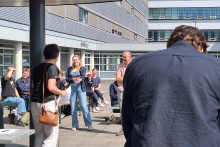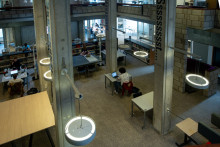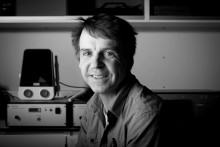Since the birth of their child, young mother Usha Rashmi Amrit, 32, and her husband, Chintan Amrit, 34, continue to follow their academic pursuits and work as scientists. Their native language is Telegu, a Dravidian language spoken by 74 million people, and though fluent in English, they are also now in the process of learning and refining their Dutch.
In 2005, the couple was married at a Sri Lankan Hindu Temple in Germany, in a small ceremony without any family members present, according to the traditions of their religion. ‘We did eventually have our “big fat Indian wedding” with all our family present in India,’ jokes Usha, ‘but because my mother believed January 7th was an “auspicious” date to marry, and we’d be truly blessed with good fortune and a happy marriage, we decided to get married on that date.’
Usha is a scientific researcher in the Engineering of Fibrous Smart Material group, working under the supervision of Professor Marijn Warmoeskerken. She was hired almost three years ago after waiting for her Visa papers to enter the Netherlands. ‘We had complications. Chintan had to swear in a Dutch court of law that our marriage was indeed valid. It took a long time,’ says Usha who had to live apart from her husband for one year and four months, usefully filling her time by conducting research.
She studied Textile and Clothing Management, specializing in the area of technology, at Niederrhein University of Applied Sciences in Moenchengladbach, Germany. ‘I’m working on short-term industrial projects for companies in the private sector that need to have research conducted on the topic of textiles but sometimes on fibers,’ she says. While in Germany, she interned as a student assistant in the Physics lab at the university and later at a textile company, Texplorer, where she conducted research to solve minor glitches and problems in desert camouflage tents used in the German army. Her specific task was to study the textiles to provide camouflaging properties in Infra Red and Radar aspects.
While his new bride, Usha, waited patiently in Bangalore, India, Chintan was working on completing his PhD under Professor Jos van Hillegersberg who at the time worked at Erasmus University in Rotterdam and later moved to Enschede to fill an opening position as Chair in Design and Implementation of Information Systems.
As part of the TESNA (TEchnical Social Network Analysis) project, Chintan and fellow colleagues have developed a new method and tool for project managers to use in order to identify specific coordination problems termed Socio-Technical Structure Clashes (STSCs). The researchers evaluated the TESNA method and tool in two commercial studies and in Open Source development environments.
Chintan credits in part the work of a professor at Carnegie Melon University in Pittsburgh, Jim Herbsleb, who helped acknowledge the importance of merging the social sciences with technical sciences, affirming the creditability of his work on his final thesis titled ‘Social-Technical Congruence in Software Engineering.’
He claims in today’s dynamic and distributed development environment there are significant challenges for software project management. In distributed project settings, he says, ‘management by walking around’ is no longer an option, and project managers may lose sight of key project insights. At the same time, the high coordination requirements of the dynamic distributed environment can cause many coordination difficulties and could lead to coordination breakdowns.
In response to some of these problems, researchers in his field have begun to develop detailed patterns for describing the preferred relationships between team communication structure, often called the ‘social network’ and modern technical software architecture. He names these patterns ‘Socio-Technical Patterns’ which are potentially useful for project managers to plan and monitor complex development projects. However, he points out these patterns are hard to implement and monitor in practice.
The main reason behind this difficulty is in finding coordination problems to apply solutions provided by the Socio-Technical Patterns, as he thinks purely manual techniques are far too labour intensive. Chintan: ‘Especially within the dynamic and iterative distributed environments, the use of Socio-Technical Patterns is challenging. But, even in small companies that employ between 20 and 50 developers, the social network and the relation to the software tasks can get quite complicated for the software manager to track.’
 |
| Usha Amrit (left): ‘We always try to attend academic conferences together. Chintan will be going to Indiana in the US, and the soon baby will be travelling with us to Lithuania.’ |







